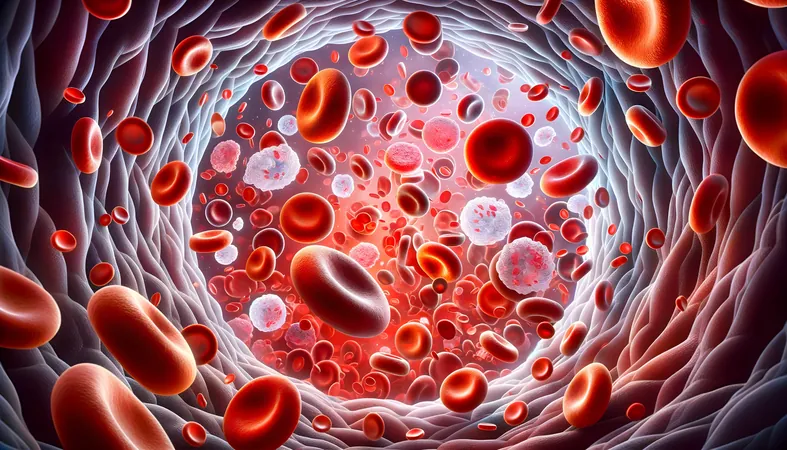
Unmet Needs and Poor Prognosis for Secondary Acute Myeloid Leukemia Patients After Treatment with Hypomethylating Agents
2025-01-18
Author: Wei Ling
Introduction
Patients grappling with secondary acute myeloid leukemia (sAML) are facing daunting challenges in treatment outcomes, particularly following their previous use of hypomethylating agents (HMAs) for myeloid neoplasms. A pivotal study published in the journal *Cancer* has shed light on the urgent need for enhanced research and innovative therapeutic interventions targeted at this vulnerable patient population.
Epidemiology and Patient Demographics
Secondary acute myeloid leukemia accounts for roughly 25% to 30% of total AML cases, predominantly arising from patients with a history of high-risk myelodysplastic syndromes (MDS) or chronic myelomonocytic leukemia (CMML). The authors of the study emphasized that a significant hurdle in managing sAML lies in the older demographic it affects, who often present with multiple comorbidities and poorer overall health statuses, specifically reflected by their Eastern Cooperative Oncology Group (ECOG) performance scores. This complicates their ability to tolerate intensive chemotherapy intended for potentially curative treatment.
Study Findings and Data Accessed
Among the study’s findings, an overwhelming 84% of the 479 sAML patients had previous exposure to HMAs, as they are a common first-line treatment for MDS. The authors accessed data from the prestigious Programa Español para el Tratamiento de Hemopatías Malignas (PETHEMA) registry, encompassing a repository of AML cases diagnosed in Spain, Portugal, Chile, and Colombia over nearly two decades. In a thorough review of 15,119 AML patients cataloged from December 2003 to August 2023, they identified that 3,657 (approximately 24.2%) had sAML, with a subset of 2,322 developing sAML following MDS.
Demographics and Genetic Assessments
Demographics reveal that the median age of patients with HMA-associated sAML in the registry was a concerning 70 years, with 67% of the cases being male. Genetic assessments found a mixed bag of cytogenetic risks: 30% exhibited normal karyotypes, while 51% faced adverse cytogenetic risk factors, hinting at the varied complexity of the disease.
Treatment Outcomes
In terms of treatment received, of the 450 patients with documented frontline therapy, only 31% underwent intensive chemotherapy. Furthermore, 19% were in low-dose cytarabine-based regimens, and 12% received HMA monotherapy. Remarkably, only 27% of patients achieved complete remission (CR), with intensive regimens showing improved CR rates over alternatives.
Survival Analysis
Survival analysis painted a stark picture; the median overall survival (OS) rate stood at a sobering 4.93 months. However, those undergoing intensive chemotherapy enjoyed slightly better outcomes, with median OS figures reaching 7.68 months. Patients who underwent allogeneic hematopoietic stem cell transplantation during their first remission, though a minority (9%), reported significantly improved survival, with median OS not even reached in that cohort.
Prognostic Factors
The multivariate analyses indicated several adverse prognostic factors, including age (65 years and older), an ECOG score higher than 2, elevated white blood cell counts, and adverse-risk cytogenetic profiles. Notably, NPM1 mutations were singled out as a favorable prognostic factor, offering glimmers of hope amid the bleak prognosis.
Conclusion and Future Directions
The authors concluded that despite the current array of therapies, including BCL2 inhibitors, patients afflicted with HMA-sAML have not seen substantial improvements across the board. They advocate for the necessity of prior effective initiatory treatments, coupled with allogeneic stem cell transplantation as a potential optimal course of action. The compelling results underline an urgent call for innovative treatment strategies and the prioritization of clinical trials for this often-overlooked patient demographic.
Urgent Need for Research
The research underscores a critical juncture in the fight against AML, where the urgency for breakthroughs in treatment approaches for sAML patients has never been more pronounced.



 Brasil (PT)
Brasil (PT)
 Canada (EN)
Canada (EN)
 Chile (ES)
Chile (ES)
 Česko (CS)
Česko (CS)
 대한민국 (KO)
대한민국 (KO)
 España (ES)
España (ES)
 France (FR)
France (FR)
 Hong Kong (EN)
Hong Kong (EN)
 Italia (IT)
Italia (IT)
 日本 (JA)
日本 (JA)
 Magyarország (HU)
Magyarország (HU)
 Norge (NO)
Norge (NO)
 Polska (PL)
Polska (PL)
 Schweiz (DE)
Schweiz (DE)
 Singapore (EN)
Singapore (EN)
 Sverige (SV)
Sverige (SV)
 Suomi (FI)
Suomi (FI)
 Türkiye (TR)
Türkiye (TR)
 الإمارات العربية المتحدة (AR)
الإمارات العربية المتحدة (AR)